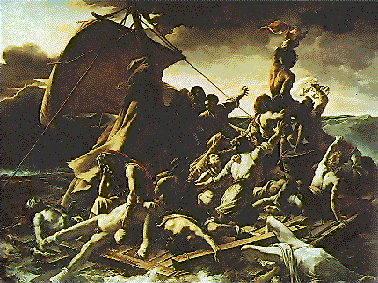
The Raft of the Medusa
The Raft of the Medusa measures approximately 16'
x 23' and was painted by Théodore
Géricault between 1818 and 1819. The painting
lives at the Louvre in Paris, France.
The Pogues evidently thought highly of the painting. It
was modified to be the cover of the Rum, Sodomy,
& the Lash release. Jem Finer also wrote a song
titled "The
Wake of the Medusa" for the Hell's Ditch
release.
"THÉODORE GÉRICAULT (1791-1824) studied
with an admirer of David (P. N. Guérin), but in
the pupil the rigid neoclassicism of the Davidian
school receded to allow David's use of sharp light and
shade to come to the fore. Géricault's work is
also characterized by a maturing of the naturalistic
element and further movement toward the dramatic
presentation of contemporary events on huge
canvases. For Géricault (unlike his
predecessors), these events did not always demand a
central hero. His masterpiece, Raft of the
Medusa, shows these influences as well as those of
Michaelangelo and Peter Paul Rubens. Géricault
took for his subject the ordeal of the survivors of
the french ship Medusa, which had foundered of
the west coast of Africa in 1816, laden with Algerian
immigrants. This incident was the result of tragic
mismanagement and provoked scandal in France when the
survivors were able to tell their
stories. Géricault's depiction of the anguish
of the event was construed by the government as an
outright political attack. The artist avoided showing
the most horrific aspects of the tragedy - murder,
cannibalism, and immense hardship - in choosing to
depict the dramatic moment when the frantic castaways
attempted to attract the attention of a distant ship
that was eventually to rescue them. Fifteen survivors
and several corpses are piled onto one another in
every attitude of suffering, despair, and death
(recalling Gros's Pest House) and are arranged
in a powerful X-shaped composition. One light filled
diagonal axis stretches from bodies at the lower left
up to the figure of the black man, raised on the
shoulders of his comrades and waiving a piece of cloth
towards the horizon. The cross-axis descends from the
storm clouds and dark, wind filled sail at the upper
left to the shadowed upper torso of the body trailing
in the open sea.
"Although baroque tactics abound, Géricault's
use of shock tactics, stunning the viewer's
sensibilities, amounted to something new - a new tone
and intention that distinguished the "high" phase of
romanticism. In this phase, an instinct for the
sublime and the terrible, qualities celebrated in the
esthetic theory and art of the eighteenth century
(see, for example, Fuselli's Nightmare), found
sharpest expression in a method of reportorial
accuracy far more stringent than that found in certain
works by David. The value Géricault placed on
accuracy in Raft of the Medusa is indicated by
the fact that he carried out prodigious research and
completed numerous preliminary studies for the work,
even going so far as to interview survivors of the
wreck.
[...]
"In Géricault's paintings, suffering, death,
and madness amounted to nature itself, for nature, in
the end, is formless and destructive." *
This scan of the painting originated at the Louvre's web
page, at http://www.paris.org/Musees/Louvre/Treasures/Paintings/.
* - From Art Through the Ages, Ninth Edition,
Vol. II by De La Croix, Tansey, and
Kirkpatrick (Copyright 1991, 1986, 1980, 1975,
1970, 1959, copyright 1948, 1936, 1926),
pp. 873-874
-
ISBN:
-
0-15-503769-2 (Hardbound)
-
0-15-503770-6 (paperbound, Vol. I)
-
0-15-503771-4 (paperbound, Vol. II)

Your intrepid maintainer is DzM.
|